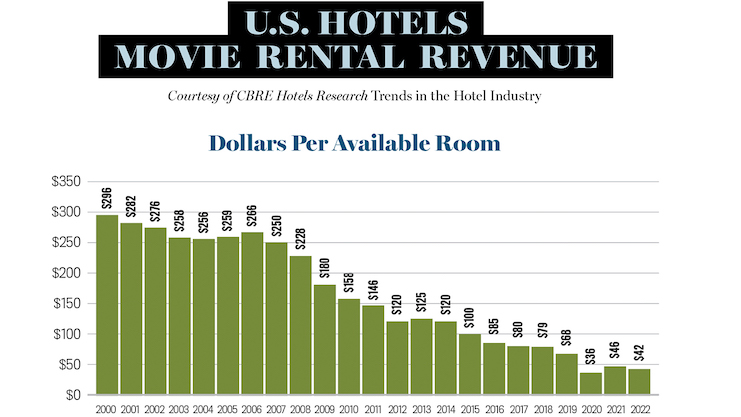
To make their guests “feel at home,” hotels have had to continually update the entertainment offerings in their guestrooms to match the amenities purchased for home use. Radios were first introduced at the Boston Park Plaza Hotel in 1927, followed by the offering of televisions at the Roosevelt Hilton in New York City in 1947. In the 1960s, hotels and motels began to proudly promote the advent of color televisions, and during the 1970s, hotels started to offer the option of free movie channels or pay-per-view movies. Now, guests use the hotel TV as a monitor for streaming content from their portable devices. To provide some historical context to the use of the guestroom television as a source of revenue for U.S. hotels, we analyzed movie rental revenue trends from 2000 through 2022. Movie rental revenue is derived either from systems that are operated by the hotel or via arrangements with third-party vendors that provide the property with a net commission payment. The data comes from CBRE’s proprietary Trends in the Hotel Industry annual survey of operating statements from thousands of properties across the United States.
A Minor and Declining Source of Revenue
The reporting of movie rental revenue for CBRE’s Trends survey peaked in 2005, when 63.1 percent of the properties in the sample reported earning revenue from guests that paid for programming from pay-per-view channels or in-room DVDs. Since then, the percentage of properties reporting movie rental revenue has declined dramatically. During the past seven years, less than 10 percent of the properties in the Trends sample reported earning any movie rental revenue. This pattern coincides with the rise in portable technology that provides guests with their own direct access to streamed entertainment. In the early 2000s, movie rental revenue was reported by a diverse profile of full-service, limited-service, extended-stay, and resort hotels distributed among all chain scales. In recent years, the few properties that have reported movie rental revenue tend to be full-service and resort hotels operating in the upper-upscale and luxury segments.
Movie rental revenue has always been a very minor source of income for U.S. hotels. Even during the peak reporting years of the early 2000s, movie rental revenue never exceeded 0.5 percent of total operating revenue at the hotels in the Trends sample. In 2022, movie rental revenue reached a historic low at 0.04 percent of total revenue.
From 2000 through 2022, movie rental revenue declined by a compound annual change rate (CAGR) of 8.5 percent. For comparison purposes, total operating revenue at these same hotels increased by a CAGR of 2.0 percent. Not only have hotels earned less revenue from movie rental, but the yield per occupied room has also declined. In 2000, the average occupied hotel room spent $1.19 per night renting movies. By 2022, this metric fell to just 17 cents per occupied room.
Other Uses of the Television
Guests now can travel with their own portable technology, which enables them to customize their own entertainment during their stay. One of the more popular amenities now offered in guestrooms is the ability to project streaming content from a mobile device on to a big-screen TV. Guests expect to be able to sign into streaming platforms, have a video call, and access social media platforms from the comfort of their rooms. Other uses for TVs are curated messages for the guests, from personalized welcome notes to group agendas to ordering room service and learning more about a hotel’s spaces and programming. The newest interactive platforms allow guests to start a movie in one city and finish the movie at their next destination. It saves the guest experience settings such as room temperature controls, and if a guest chooses to watch one channel a few times, that channel would be a one-click access point in the future. This level of guest care and personalization is the future of our industry.
Beyond the Television
In today’s hotels, in-room entertainment has moved beyond the television. It is just one part of the overall in-room technology package that includes Internet services, streaming, and other smart interactions.
While improving guest satisfaction is the primary motivation for offering the latest in in-room entertainment, some amenities can also be a source of revenue. Given CBRE’s forecast of modest gains in rooms revenue through 2027, any additional sources of income are welcome by hotel owners and operators. The right interactive technology through the in-room entertainment devices—tablets, TVs, or AI—can go beyond allowing guests to stream their favorite TV show or catch a live sports game. Elevating the in-room technology can drive some revenue by allowing guests to book services, receive targeted promotions, customize their experience, and access on-demand wellness and meditation programs.
Hotels have started using AI through the TV, tablets, and smaller devices such as Alexa or Echo to communicate with guests, answer questions, make travel suggestions, and book ancillary services—a virtual butler. Aside from being a novelty, this kind of tool allows the guests to engage with the hotel spaces and get immediate answers and attention while at the same time freeing up some hotel resources.
Guest wellness has also guided the in-room amenities now offered in hotel rooms. Upgrade options for rooms featuring fitness equipment or meditation-guided classes are good revenue generators and guest-pleasing options.
In-Room Amenities Need to Provide Value
Seamless and state-of-the-art in-room technology will drive loyalty and be a differentiator for any hotel. In our opinion, state-of-the-art technology is a legitimate value worth justifying urban and destination fees. Regardless of the technology, it must be hassle-free, since the fastest way to lose a customer is through confusion and frustration.
The bottom line is that guests are willing to pay extra for hotels that curate and personalize in-room amenities, and these amenities vary significantly depending on whether it is a luxury hotel or a business-class hotel. At the luxury level, hotels should reconsider giving guests expensive “gifts” and instead focus on delivering a personalized experience. The sugary welcome amenities are finally being changed to thoughtful smaller amenities that promote wellness.














